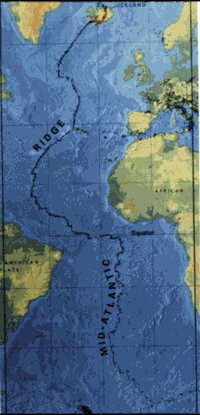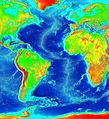Mid-Atlantic Ridge facts for kids
The Mid-Atlantic Ridge is like a giant underwater mountain range that runs right down the middle of the Atlantic Ocean. It's a very special place because it's where new ocean floor is constantly being made! Imagine it as a long crack in the Earth's crust where hot material from deep inside pushes up.



This amazing underwater mountain range is part of a huge system of ridges that circles the entire Earth. It's actually the longest mountain range in the world! Most of it is hidden deep under the ocean, but in a few places, like Iceland, it pops up above the water.
In the northern part of the Atlantic, the Mid-Atlantic Ridge separates the North American Plate from the Eurasian Plate and the African Plate. In the southern part, it separates the African Plate from the South American Plate. These "plates" are like giant pieces of a puzzle that make up the Earth's outer shell. The ridge stretches all the way from near Greenland down to the South Atlantic.
The ocean floor here is slowly spreading apart, like a conveyor belt. This happens at about 2.5 centimeters (1 inch) per year. That's about how much your fingernails grow in a year!
Contents
Discovering This Underwater Giant
People didn't always know about this huge underwater mountain range. The Mid-Atlantic Ridge was first found during an expedition by a British ship called HMS Challenger in 1872. Scientists on board were exploring the ocean floor. They were trying to find the best place to lay a transatlantic telegraph cable, which would allow messages to be sent across the ocean. During their journey, they discovered a large rise in the middle of the Atlantic.
Later, in 1925, the existence of this ridge was confirmed using sonar. Sonar uses sound waves to map the ocean floor, much like bats use sound to find things in the dark.
In the 1950s, more detailed maps of the ocean floor showed that the Mid-Atlantic Ridge had many valleys and smaller ridges. Scientists also noticed that its central valley was very active with many earthquakes. This led to a big discovery: the Mid-Atlantic Ridge was part of a 40,000-kilometer-long (about 25,000 miles) system of underwater mountain ranges that goes through all of Earth's oceans!
Finding this worldwide ridge system was a huge step. It helped scientists understand and accept the ideas of seafloor spreading and continental drift. These ideas explain how Earth's continents move over time, which we now call plate tectonics.
What Makes It Special?
The Mid-Atlantic Ridge has a deep crack running right down its middle. This crack is called a rift valley. It's where the edges of the tectonic plates meet and pull apart.
At this rift, hot, melted rock called magma comes up from deep inside the Earth. When this magma reaches the ocean floor, it cools down and hardens. This hardened magma forms new basalt and gabbro rock, creating brand new ocean crust! It's like the Earth is constantly making new skin for its ocean floor.
Near the equator, the Mid-Atlantic Ridge is split into two parts by a very deep underwater ditch called the Romanche Trench. This trench is one of the deepest spots in the Atlantic Ocean, going down about 7,758 meters (25,453 feet)!
How It Formed
The Mid-Atlantic Ridge started to form a very long time ago, at the end of the Triassic period. This was when the supercontinent Pangaea began to break apart. Imagine Pangaea as one giant landmass that included all the continents we know today. As Pangaea split, the Atlantic Ocean started to open up, and the Mid-Atlantic Ridge was born. It's responsible for separating the Americas from Africa and Europe.
The ridge sits on top of a large bulge under the ocean called the Mid-Atlantic Rise. This bulge is thought to be caused by hot rock pushing up from deep inside the Earth, lifting the ocean floor.
Images for kids
-
Basaltic rocks of the Mid-Atlantic Ridge observed by the Hercules ROV during the 2005 Lost City Expedition
See also
 In Spanish: Dorsal mesoatlántica para niños
In Spanish: Dorsal mesoatlántica para niños





